Sixteen Tons Part 1: How Coal is Formed
Coal has been in the news a lot lately, what with climate change and Donald Trump's promise to restore coal mining jobs. Before we talk about that, though, let's rewind a bit to talk about where coal comes from. More than a bit, really. We're going back almost 360 million years, to the dawn of the Carboniferous.
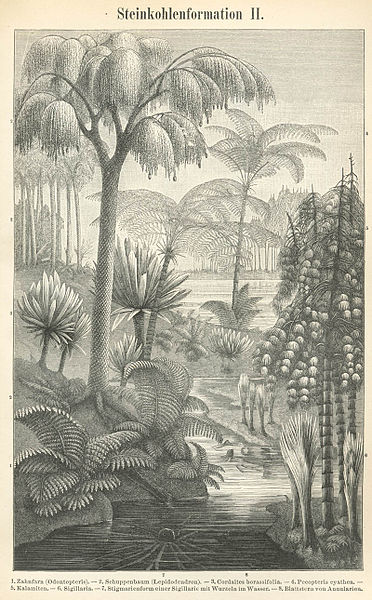
An 1880s German illustration of the Carboniferous era. [Image source]
The Carboniferous (sometimes referred to as the Mississippian and the Pennsylvanian in America) was a hot, humid period, at least for the first half or so. It featured a thicker atmosphere and much higher oxygen levels than are present on Earth today, which in turn led to much, much windier conditions and far more powerful winds than we see today. Seas were generally shallower than today, the Appalachians were rising out of the ground, and Pangea was busy assembling itself.
These conditions both lead to and were caused by the growth of massive tropical rainforests, dwarfing anything we have on Earth today. (Or, I should say, dwarfing even the rainforests we had before we started cutting them down.) Like many things in nature, cause and effect relationships are hopelessly tangled. The warm conditions ample precipitation allowed trees to spread rampantly, which in turn resulted in the trees adding more and more oxygen to the atmosphere. This same oxygen allowed the growth of truly massive insects- the largest to ever exist.
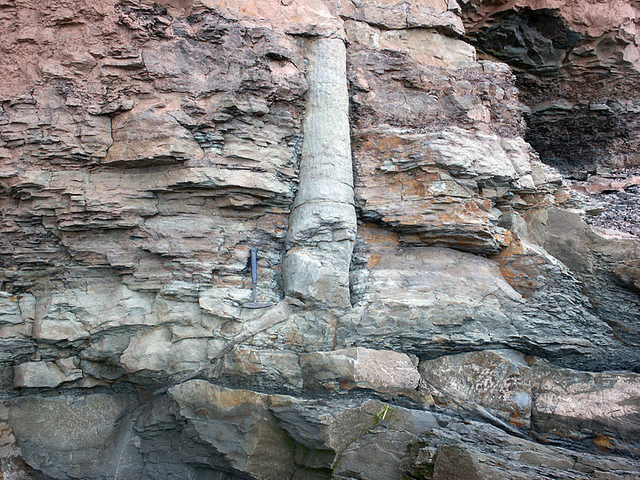
A lycopsid fossil. Lycopsids were clubmosses that reached heights comparable to modern trees- one species from the late Carboniferous could reach 50 meters in height. Despite their height, they are mostly unrelated to modern trees. [Image source]
This was the rainforest's first appearance ever. Lignin, or wood fiber, and suberin, the waxy substance that helps seal bark, both evolved during the early Carboniferous. The forests, however, where vastly different than ours. The "trees" were, for the most part, more primitive plants like lycopsids (giant club mosses), Lepidodendrales (scale trees), giant ferns, and horsetails. Later in the Carboniferous more familiar trees started appearing, but that was millions of years and at least one large scale extinction later. The trees that did exist then made ample use of lignin. Many of them had bark to wood ratios of 8 to 1 or higher, compared to modern valued of 1 to 4.
There was a problem, however- the trees weren't decomposing. This was due to a couple of different factors. First of all, there weren't many decomposers that had evolved to handle wood and bark yet, and those that existed were overworked. Next, lignin is difficult for even modern decomposers to break down- very specialized species have evolved to handle it. For ancient decomposers it was next to impossible.
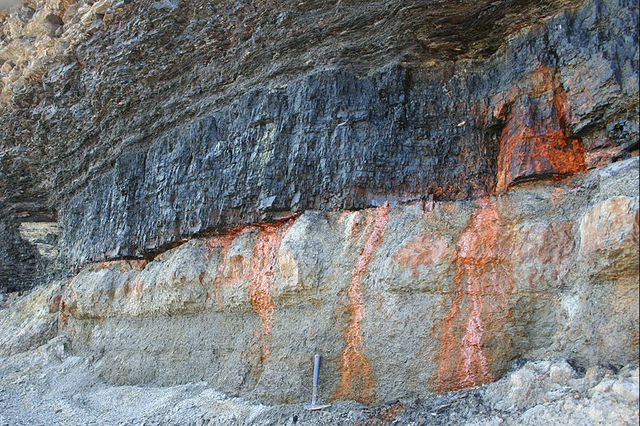
An exposed coal seam in Nova Scotia. [Image source]
This lead to the buildup of massive amounts of dead trees. There were some significant side effects of this. The combination of huge amounts of dead wood and much higher oxygen levels resulted in truly massive wildfires, dwarfing anything we have today. Not for lack of trying on our part, either- our wildfires are pretty severe, thanks to climate change and decades of forest mismanagement. Atmospheric CO2 levels dropped even lower as more and more was converted into tree trunks, and more and more oxygen was emitted. Chunks of dead wood drifted down streams and rivers in such quantities that it completely changed oceanic ecosystems- the bits of dead wood lead to a massively more productive ecosystem, including, among other things, the explosion of new ammonite and other cephalopod species.
More importantly for our immediate purposes, however, it piled up in lowland swamps and forests. These areas are commonly found in 'downward escalator' geological zones. This means that the area is undergoing subsidence- essentially, it's sinking downwards under the weight of all the sediment being piled up. In this case, trees. Peat bogs were formed and buried. At no point since have as many peat bogs existed or as many trees been buried as during the early Carboniferous. Of course, the early Carboniferous doesn't have a monopoly on coal- it's been formed in most time periods since. There's coal forming today. By far the biggest deposits are from the Carboniferous, however. Ironically, the same conditions that lead to the impressive coal formation of the early Carboniferous bore the seeds of its own destruction. The massive amounts of carbon dioxide being taken out of the atmosphere eventually lead to a breakdown of the greenhouse effect and a death of much of the Carboniferous rainforest in a minor extinction event known as the Carboniferous rainforest collapse.
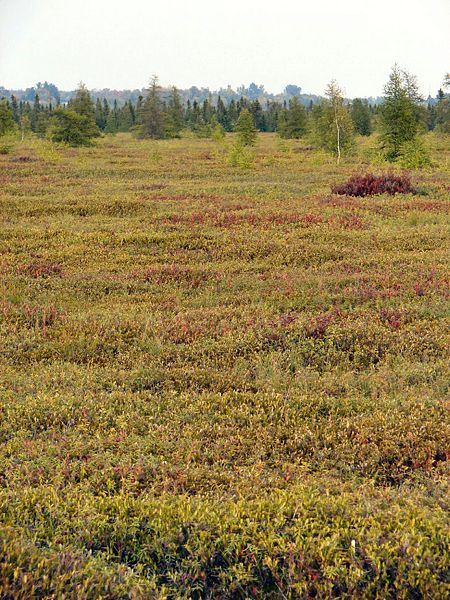
Peat bogs, like this fairly typical one in Canada, tend to just look like soggy flat areas with few to no stunted trees. In actuality, they're waterlogged masses of vegetation up to hundreds of feet deep. You can walk on them, but any heavy vehicle or building is just going to sink straight into them. [Image source]
As these peat bogs were carried down into the ocean by subsidence and other 'downward escalator' geological processes, they were quickly covered up by other layers of sediment. As these layers above began to build up, more and more pressure was applied to the coal. It slowly began to convert into coal through metamorphic processes- the application of heat and pressure underground. There was a specific sequence that this followed. There are a number of individual grades of coal out there. With each increasing grade, the coal had undergone further metamorphosis, starting out as sediment, moving through sedimentary rock, and eventually some moving towards becoming metamorphic. As the grades get higher, the coal produces fewer harmful toxins- though it's never free of them- and more greenhouse gases.
Peat was the precursor to coal- basically flammable mud. Lignite, brown coal, is the next rank. Interestingly, the gemstone jet is just highly compacted lignite. After that you get bituminous coal- still a sedimentary rock, but much denser. Anthracite is the highest grade of coal. It's a partially metamorphosed coal, and unfortunately makes up a quite small amount of the total remaining coal in the world. Finally, the coal is converted to graphite, which makes a poor fuel, being too dense to ignite well. All of these types are found in thick, flat lying layers- just like any other sedimentary rock. This has major consequences for the mining of coal.
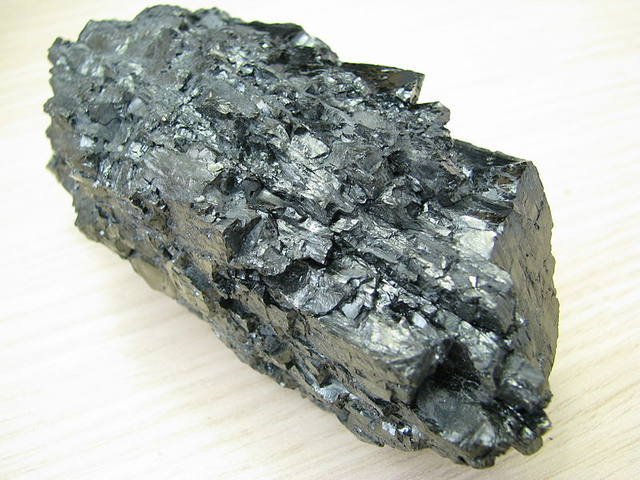
Anthracite, the highest grade of coal. [Image source]
Next time: The Environmental and Human Costs of Coal
Bibliography:
The Emerald Planet: How Plants Changed Earth's History, by David Beerling
Squid Empire, by Dana Staaf
Life: A Natural History of the First Four Billion Years of Life on Earth, by Richard Fortey
http://www.devoniantimes.org/who/pages/lycopsid.html
https://en.wikipedia.org/wiki/Coal
https://en.wikipedia.org/wiki/Anthracite
https://en.wikipedia.org/wiki/Carboniferous
https://en.wikipedia.org/wiki/Carboniferous_rainforest_collapse
https://en.wikipedia.org/wiki/Bog
https://www.eia.gov/tools/faqs/faq.php?id=73&t=11
Being A SteemStem Member
Great post. I'm originally from Cape Breton Island, which is a quaint island off of Nova Scotia, and happens to be representing the Upper Carboniferous with much pride. Coal was a huge industry there in the day but the roots of its ancient past are still quite present.
You could throw a rock any area with some ocean erosion and find giant chunks of Anthracite, and any number of nondescript fossils. A closer inspection would allow you to uncover some fern impressions, Chunks of Calamites sp ,trace chunks of what we used to call "coal wood", and many other types of evidence from that time period.
I actually have a pretty good representative selection of fossils from the area which I rescued from waste rock piles over the years. I used to report them to local fossil centers, and the university but they were never interested. I would usually save them the fate of becoming armor stones, fill for roadways, gravel, etc..
You may have inspired me to share some posts of my mineral and fossils specimens collected from Canada and the US . Kudos.
You definitely should share them! It'd be a good thing to post one of every day along with whatever other post you do.
Excellent post as always.
Growing up in a coal mining town in the Appalachians and loving the environment as much as I do was a huge conflict for me... Coal mining was the economy and I kind of wanted the whole area to move towards a better solution for energy (solar or wind) as it would have been possible.
When the coal miners started losing their jobs, my whole area was hit hard and hardly anyone had money for anything. But that's neither here nor there.
Jobs are coming back, but, not as much as Trump promises. Need buyers of coal or mining coal is useless so until Trump or whoever can convince countries they need coal from the US people should not get their hopes up.
Also, coal is absolute shit to peoples' lungs. Some of my family members have it, it sucks.
This is the "clean coal" people are trying to push. They say they can process any coal through treatments to make it less harmful... hogwash.
Sorry for ranting.
Oh, trust me, the rest of the series is going to be scathing towards coal companies and the prospect of coal's return. Part 2 should be showing up later today.
I look forward to reading it and the rest of the series.
If you ever want to read up on mine disasters this is a pretty good start.
Oh, trust me, I've read entirely too much about mining disasters. :(
I think small education pieces like this are important. Many people still think coal comes from dead dinosaurs, and believe the myth of "clean coal". Thank you for including that the coal never gets completely toxin-free, and greenhouse gases are still present as well. I live in Eastern Ohio, and we have some coal bed near us. Mostly natural gas from the Utica Shale, though. Again, great job.
Thanks!
Gave you some formatting tips on discord.
Excellent article. I never posted or followed anything in #geology yet, although I have a good documentation on the subject. Cheers!
You should check the geology tag out, there's a lot of great stuff! You should also check out @geopolis , an earth science curation group.
it seems i was following @geopolis already, and I will read more
Such a detailed write-up from you @mountainwashere :) I have read and studied a little about coal formation in science but you have fed me a whole new level of information! Great effort and thank you!
Detailed explanation, really enjoyed reading.
You received a 80.0% upvote since you are a member of geopolis.
To read more about us and what we do, click here.
https://steemit.com/geopolis/@geopolis/geopolis-the-community-for-global-sciences-update-3
If you do not want us to upvote and comment on your posts concerning earth and earth sciences, please reply stop to this comment and we will no longer bother you with our love ❤️
Your Post Has Been Featured on @Resteemable!
Feature any Steemit post using resteemit.com!
How It Works:
1. Take Any Steemit URL
2. Erase
https://3. Type
reGet Featured Instantly � Featured Posts are voted every 2.4hrs
Join the Curation Team Here | Vote Resteemable for Witness
Just awesome your post dear friend @mountainwashere
Thanks, though your comment feels a little like spam- it doesn't say anything about my actual article, it was posted less than two minutes after my quite long post went up, and you have a bunch of similar comments in your comment history.
No dear this is my real comments not copy and past
So... what did you like about my post, then?
The possible rewards :D